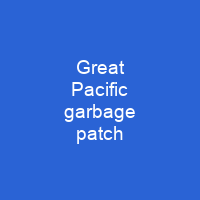The Great Pacific garbage patch, also described as the Pacific trash vortex, is a gyre of marine debris particles. It is located roughly from 135°W to 155°W and 35°N to 42°N. Despite the common public perception of the patch existing as giant islands of floating garbage, its low density prevents detection by satellite imagery, or even by casual boaters or divers in the area.
About Great Pacific garbage patch in brief

The patch is believed to have increased 10-fold each decade since 1945. Some of the Plastic in the patch is over 50 years old, and includes items such as plastic lighters, toothbrushes, water bottles, pens, baby bottles, cell phones, plastic bags, and nurdles. In 2009, two project vessels from Project Kaisei, Ocean Voyages Institute, embarked on a voyage to research the patch and determine the feasibility of commercial scale collection and recycling. The JUNK Raft Project was a 2008 trans-Pacific sailing voyage made to highlight the plastic in thePatch. In 2010, Ocean voyages Institute conducted a 30-day expedition in the Gyre which continued the science from the 2009 expeditions and tested prototype cleanup devices. In July & Aug 2012 Ocean Voyage Institute made a voyage from San Francisco to the Eastern limits of the North Pacific Gyre north, and then made a return voyage which also visited theGyre. The gyre is divided into two areas, the \”Eastern Garbage Patch\” between Hawaii and California, and the \”Western Garbage patch\” extending eastward from Japan to the Hawaiian Islands. The Gyre is frequently featured in media reports as an exceptional example of marine pollution. The area is also used to study the impact of plastic on mesopelagic fish, such as lanternfish. The concept makes use of floating booms that catch the debris rather than collecting bycatch, while even the smallest particles.
You want to know more about Great Pacific garbage patch?
This page is based on the article Great Pacific garbage patch published in Wikipedia (as of Dec. 09, 2020) and was automatically summarized using artificial intelligence.







